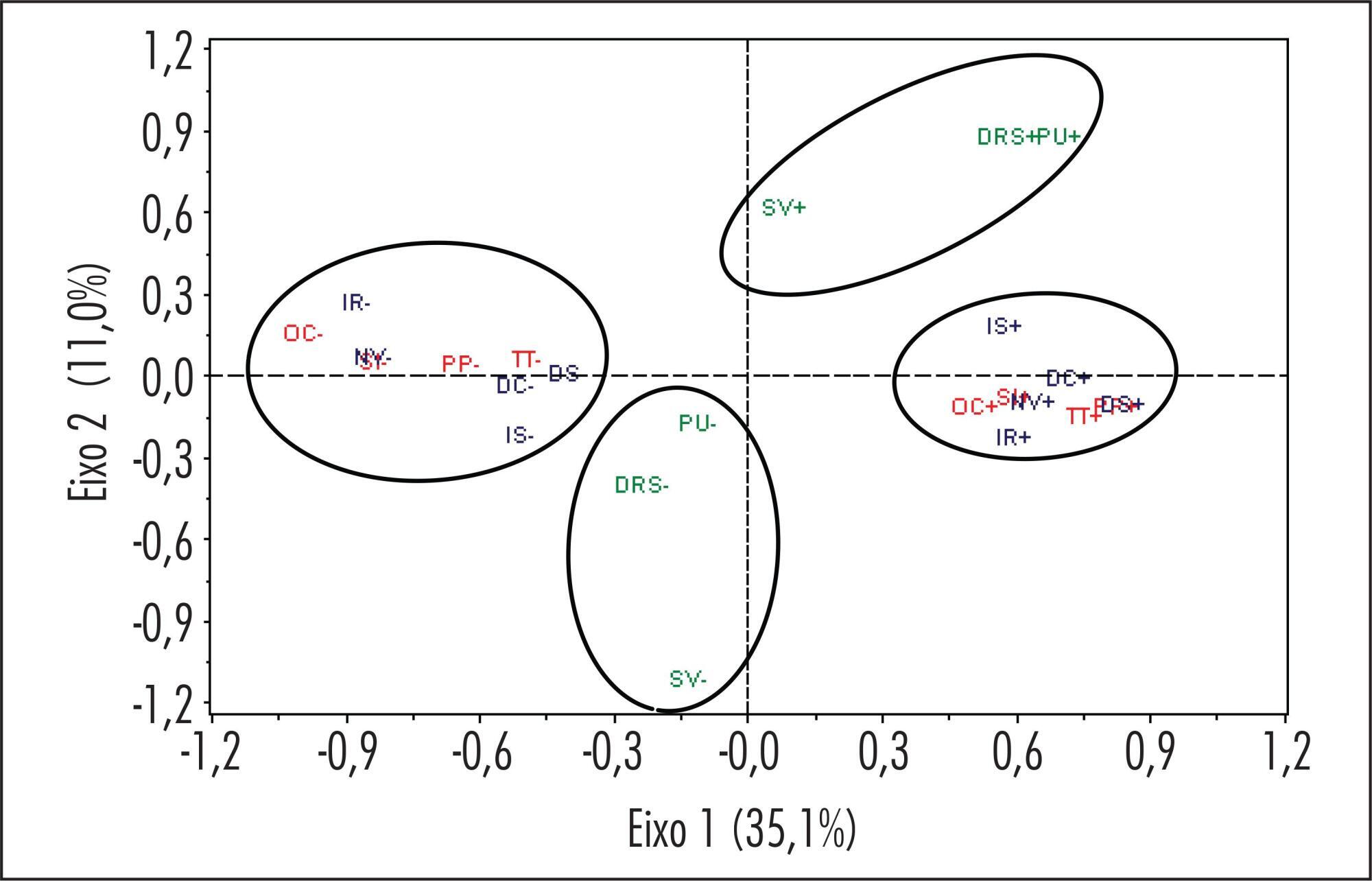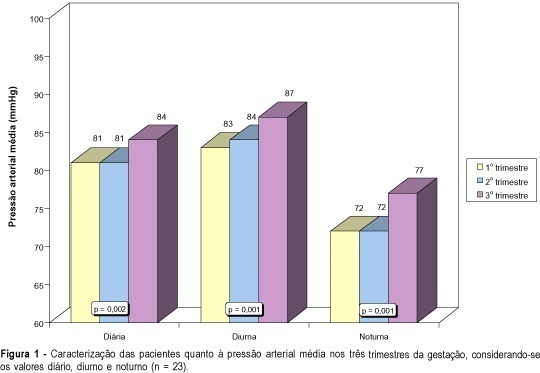Summary
Revista Brasileira de Ginecologia e Obstetrícia. 2014;36(4):163-169
DOI 10.1590/S0100-7203201400040002
To assess the prevalence of Climacteric Syndrome (CS) in women from a municipality of Northeastern Brazil which is less developed socioeconomically.
A prospective household survey was performed in São Luís, Maranhão, Brazil with 1,210 climacteric women aged 45 to 60 years. Interviews were applied using previously tested standard questionnaires from April to July 2008. The severity of climacteric symptoms was analyzed by circulatory and psychological indexes and the latter were associated with menopausal status. Multiple correspondence analysis was used to assess the relation among climacteric symptoms.
Most patients were 55 to 60 years old (35.3%), mulatto (37.9%), with 9-11 years of schooling (39.8%), with a partner (56%), Catholic (73.9%) and belonged to the socioeconomic class C (51.1%). The prevalence of CS was 85.9%, and hot flashes (56.4%) and sweating (50.4%) were the most prevalent symptoms. The most frequent psychological symptoms were nervousness (45%) and emotional liability (44.8%). The severity of vasomotor and psychological symptoms was significantly higher during the peri and postmenopausal period (p<0.05). Vaginal dryness (62.7%) was the most prevalent urogenital complaint.
The prevalence of CS was high among women from São Luís, Maranhão, Brazil.

Summary
Revista Brasileira de Ginecologia e Obstetrícia. 2003;25(3):163-167
DOI 10.1590/S0100-72032003000300004
PURPOSE: to show longitudinally the profiles and parameters of pressure rhythm and heart rate in normotensive pregnant women during the three trimesters of pregnancy. PATIENTS AND METHODS: the longitudinal and random study involved 23 normotensive pregnant women, mean age 23.3 ± 3.9 years, recruited from the prenatal clinics of the "Maternidade-Escola Hilda Brandão - Santa Casa de Belo Horizonte/MG". Ambulatory blood pressure monitoring was done every three months (up to 14 weeks, between 18 and 28 weeks and between 32 and 40 weeks, using the SpaceLabs monitor, model 90207. RESULTS: a significant increase (p<0.01) in the 24-h systolic (115 and 104 mmHg), diastolic (73 and 61 mmHg) and average diurnal and nocturnal blood pressures (87 and 77 mmHg respectively), was noticed in the third trimester of pregnancy. Mother's diurnal blood pressure and heart rate (83, 84 and 87 mmHg; 94, 95 and 93 bpm) were significantly higher than the nocturnal measurements (72, 72 and 77 mmHg; 74, 79 and 79 bpm), in the three trimesters. Mother's heart frequency did not change during progress of pregnancy. CONCLUSION: increase in blood pressure during the third trimester of pregnancy could be shown. Maternal daily and diurnal heart rate did not change when the three trimesters were compared. The nocturnal heart rate was significantly lower in the first trimester as compared to the other trimesters.

Summary
Revista Brasileira de Ginecologia e Obstetrícia. 2009;31(4):164-170
DOI 10.1590/S0100-72032009000400002
PURPOSE: to determine factors associated to amniotic fluid volume and frequencies of fetal anomalies, in a reference center in Pernambuco. METHODS: a transversal study performed in high-risk pregnant women submitted to obstetrical morphological ultrasound, from March 2002 to March 2006, at an institution from Recife, Pernambuco, Brasil. The intrauterine diagnosis was confirmed after birth. Sociodemographic and obstetrical characteristics, amniotic liquid volume and presence of fetal anomalies were the variables studied. Fisher's exact, χ2, and Student's t tests, at a significance level of 5% were applied to verify the correlation among the variables. Prevalence rate and confidence interval at 95% were calculated. Multiple logistic regression analysis was performed at a significance level of 5%. RESULTS: Two hundred and fifty-seven pregnant women (56.2%) with congenital anomalies and 200 (43.8%) without anomalies, confirmed in the postnatal, were included in the study. The average of maternal ages and gestation periods were 24.8±6.5 years and 35.9±3.7 weeks, respectively. The fetal anomalies were discovered in the central nervous system (50.6%) and genitourinary tract (23.0%). The presence of congenital anomalies were significantly linked with reduced liquid/oligohydramnios (p=0.0002) and increased liquid/polyhydramnios (p<0.0001). Intrauterine mortality was more frequent in the group with anomalies, as compared to the healthy fetuses (10.5 versus 2.5%; p<0.01). CONCLUSIONS: The rate of congenital anomalies in the high-risk pregnant women group was 56.2%. Most of the central nervous system malformations were diagnosed intrauterus. Changes in the amniotic fluid were the factors more strongly associated with congenital anomalies.
Summary
Revista Brasileira de Ginecologia e Obstetrícia. 2016;38(4):164-169
The objective of this study is to associate the results obtained while assessing the pelvic floor muscles (PFM) functionality with the score of sexual satisfaction of young adult women.
This is an observational and cross-sectional study. The inclusion criteria were women aged between 20 and 40 years who have had sexual intercourse, nulliparous, BMI lower than 25 kg/m2, and absence of pelvic floor dysfunction. The evaluation consisted of both the medical history and assessment of the PFM functionality using the Perina pressure biofeedback and Oxford Scale. We measured sexual satisfaction using the Female Sexual Quotient questionnaire and used the KolmogorovSmirnov test to verify the normality of the data. We analyzed non-parametric variables using the Spearman correlation test. The significance level was 5 %.
A total of 80 women with a median age of 26 years and median BMI of 21.64 kg/m2 participated in this study. We divided the subjects into two groups, best and worse PFM functionality, according to median Perina pressure biofeedback and Oxford scale. We found no difference between the groups when comparing the sexual satisfaction scores. There was only a slight significant correlation between the Contraction Voluntary Average obtained using the pressure biofeedback and the primary domain (r = 0.27; p = 0.01).
This study found a slight correlation between PFM functionality and the functionality of the primary domain of the Female Sexual Quotient questionnaire. Therefore, it is not possible to state whether there is an association between the PFM functionality and female sexual satisfaction in young adults.
Summary
Revista Brasileira de Ginecologia e Obstetrícia. 2015;37(4):164-171
DOI 10.1590/SO100-720320150005186
To identify the factors associated with weight retention after pregnancy.
A cohort study was performed with 145 women receiving maternity care at a hospital in Caxias do Sul, Rio Grande do Sul, Brazil, aged 19 to 45 years, between weeks 38 and 42 of pregnancy. The patients were evaluated at one month, three months, and six months after delivery. Student's t-test or one-way analysis of variance (ANOVA) was used to compare groups, as indicated; correlations were assessed with Pearson's and Spearman's tests, as indicated; to identify and evaluate confounders independently associated with total weight loss, a multivariate linear regression analysis was performed and statistical significance was set at p≤0.05.
There was a significant positive association between total weight gain - and a negative association with physical exercise during pregnancy - with total weight loss. Higher parity, inter-pregnancy interval, calorie intake, pre-pregnancy body mass index (BMI), weight gain related to pre-pregnancy BMI, presence and severity of depression, and lack of exclusive breastfeeding were directly associated with lower weight loss. Among nominal variables, level of education and marital status were significantly associated with total weight loss.
In the present study, lower weight retention in the postpartum period was associated with higher educational attainment and with being married. Normal or below-normal pre-pregnancy BMI, physical activity and adequate weight gain during pregnancy, lower parity, exclusive breastfeeding for a longer period, appropriate or low calorie intake, and absence of depression were also determinants of reduced weight retention.

Summary
Revista Brasileira de Ginecologia e Obstetrícia. 2012;34(4):164-169
DOI 10.1590/S0100-72032012000400005
PURPOSE: To describe the maternal and perinatal outcomes after the use of 12.5 µg of sublingual misoprostol for labor induction in women with term pregnancy and a live fetus. METHODS: We conducted a multicenter, open and non-randomized clinical trial during the period from July to December 2009. We included 30 pregnant women with an indication for labor induction at term, carrying a live fetus, with a Bishop score of six or less, cephalic presentation, estimated fetal weight of less than 4,000 g and an amniotic fluid index greater than five. We excluded women with a previous uterine scar, non-reassuring fetal status, congenital anomalies, multiple pregnancy, intrauterine growth restriction, genital bleeding, and contraindications of vaginal delivery. A tablet of 12.5 µg sublingual misoprostol was administered every six hours, until the beginning of labor, with the maximum of eight doses. RESULTS: Labor was successfully induced in 90% of pregnant women. The mean interval between the first dose and the onset of uterine contractions and delivery was 14.3±11.7 hours and 25.4±13 hours, respectively. The frequency of vaginal delivery was 60%. Uterine tachysystole occurred in two pregnant women, being reversed in both cases without the need for cesarean section. Meconium-stained amniotic fluid was observed in four patients, and an Apgar score of less than 7 at five minutes in only one newborn. CONCLUSION: Maternal and perinatal outcomes were favorable after induction of labor with sublingual misoprostol at a dose of 12.5 µg every six hours. However, controlled trials are needed to compare this regimen with other doses and routes of administration.
Summary
Revista Brasileira de Ginecologia e Obstetrícia. 2011;33(7):164-169
DOI 10.1590/S0100-72032011000700008
PURPOSE: to analyze the gait propulsion force and relate it to changes in the dimensions of the feet and to the influence on the quality of life of pregnant women. METHODS: two groups were studied, a control (C) one consisting of 20 non-pregnant women and a group of 13 pregnant women investigated during the three gestational trimesters (Gfirst, Gsecond, Gthird). The groups were subjected to an initial assessment; evaluation of gait propulsion force using the force platform (Bertec); measurement of foot length and width; assessment of perimetry by the figure eight method; and assessment of quality of life using the World Health Organization Quality of Life Instrument Bref (Whoqol-bref). The Mann-Whitney test was used to evaluate differences between group C and Gfirst, the Friedman test was used to determine differences between Gfirst, Gsecond and Gthird, and the Wilcoxon test was applied to significant cases. The level of significance was set at 5%. RESULTS: There was an increase in body mass (10.5 kg) and ankle edema (2.4 cm) during pregnancy. There was a decrease of gait propulsion force (10% of body mass) and an increase of mediolateral sway (10% of body mass) compared to Control Group. There was a reduced quality of life among pregnnat women, especially in the physical domain. CONCLUSIONS: Gait disorders occur during pregnancy, which can increase the risk of falls and musculoskeletal discomfort, which may affect the quality of life of pregnant wome